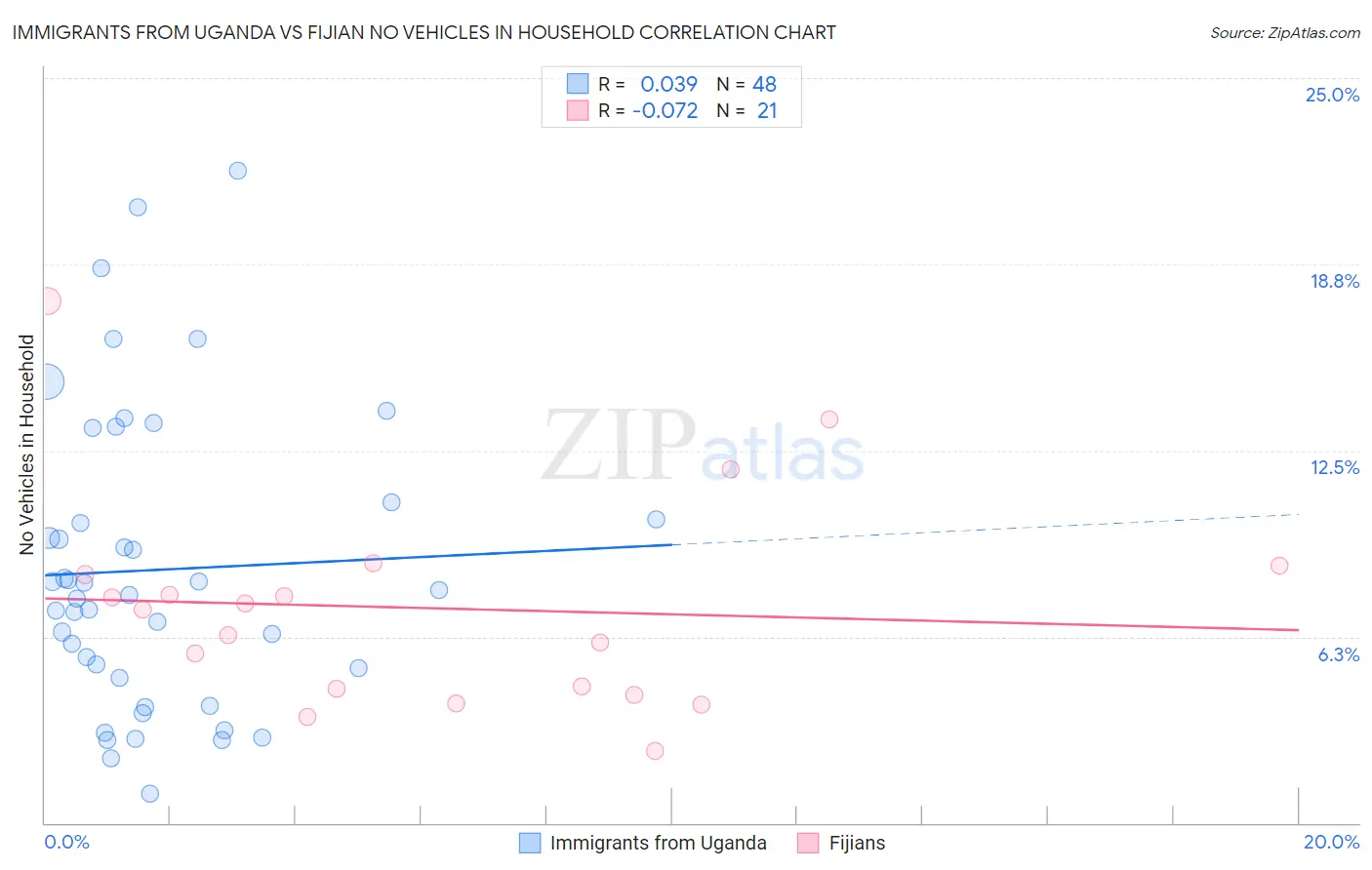Immigrants from Uganda vs Fijian No Vehicles in Household
COMPARE
Immigrants from Uganda
Fijian
No Vehicles in Household
No Vehicles in Household Comparison
Immigrants from Uganda
Fijians
10.0%
NO VEHICLES IN HOUSEHOLD
76.1/ 100
METRIC RATING
149th/ 347
METRIC RANK
9.5%
NO VEHICLES IN HOUSEHOLD
92.7/ 100
METRIC RATING
119th/ 347
METRIC RANK
Immigrants from Uganda vs Fijian No Vehicles in Household Correlation Chart
The statistical analysis conducted on geographies consisting of 125,911,604 people shows no correlation between the proportion of Immigrants from Uganda and percentage of households with no vehicle available in the United States with a correlation coefficient (R) of 0.039 and weighted average of 10.0%. Similarly, the statistical analysis conducted on geographies consisting of 55,930,698 people shows a slight negative correlation between the proportion of Fijians and percentage of households with no vehicle available in the United States with a correlation coefficient (R) of -0.072 and weighted average of 9.5%, a difference of 5.1%.

No Vehicles in Household Correlation Summary
| Measurement | Immigrants from Uganda | Fijian |
| Minimum | 0.97% | 2.4% |
| Maximum | 21.9% | 17.5% |
| Range | 20.9% | 15.1% |
| Mean | 8.5% | 7.2% |
| Median | 7.7% | 7.2% |
| Interquartile 25% (IQ1) | 5.0% | 4.4% |
| Interquartile 75% (IQ3) | 10.5% | 8.5% |
| Interquartile Range (IQR) | 5.5% | 4.1% |
| Standard Deviation (Sample) | 4.9% | 3.6% |
| Standard Deviation (Population) | 4.9% | 3.5% |
Similar Demographics by No Vehicles in Household
Demographics Similar to Immigrants from Uganda by No Vehicles in Household
In terms of no vehicles in household, the demographic groups most similar to Immigrants from Uganda are Colombian (10.0%, a difference of 0.41%), Immigrants from Eastern Africa (10.0%, a difference of 0.42%), Immigrants from Congo (10.1%, a difference of 0.56%), Immigrants from Bosnia and Herzegovina (9.9%, a difference of 0.62%), and Tlingit-Haida (10.1%, a difference of 0.65%).
| Demographics | Rating | Rank | No Vehicles in Household |
| Immigrants | Zimbabwe | 82.6 /100 | #142 | Excellent 9.9% |
| Chileans | 81.2 /100 | #143 | Excellent 9.9% |
| Immigrants | Bahamas | 81.2 /100 | #144 | Excellent 9.9% |
| Bahamians | 81.0 /100 | #145 | Excellent 9.9% |
| Hungarians | 80.0 /100 | #146 | Excellent 9.9% |
| Immigrants | Nicaragua | 79.8 /100 | #147 | Good 9.9% |
| Immigrants | Bosnia and Herzegovina | 79.1 /100 | #148 | Good 9.9% |
| Immigrants | Uganda | 76.1 /100 | #149 | Good 10.0% |
| Colombians | 73.9 /100 | #150 | Good 10.0% |
| Immigrants | Eastern Africa | 73.8 /100 | #151 | Good 10.0% |
| Immigrants | Congo | 73.0 /100 | #152 | Good 10.1% |
| Tlingit-Haida | 72.5 /100 | #153 | Good 10.1% |
| Sioux | 72.4 /100 | #154 | Good 10.1% |
| Salvadorans | 72.4 /100 | #155 | Good 10.1% |
| Immigrants | Micronesia | 70.9 /100 | #156 | Good 10.1% |
Demographics Similar to Fijians by No Vehicles in Household
In terms of no vehicles in household, the demographic groups most similar to Fijians are Immigrants from Thailand (9.5%, a difference of 0.060%), Greek (9.5%, a difference of 0.11%), Puget Sound Salish (9.5%, a difference of 0.16%), Costa Rican (9.5%, a difference of 0.21%), and Chippewa (9.4%, a difference of 0.66%).
| Demographics | Rating | Rank | No Vehicles in Household |
| Armenians | 95.0 /100 | #112 | Exceptional 9.4% |
| Immigrants | Netherlands | 94.8 /100 | #113 | Exceptional 9.4% |
| Serbians | 94.3 /100 | #114 | Exceptional 9.4% |
| Navajo | 94.2 /100 | #115 | Exceptional 9.4% |
| Japanese | 94.1 /100 | #116 | Exceptional 9.4% |
| Chippewa | 93.8 /100 | #117 | Exceptional 9.4% |
| Greeks | 92.9 /100 | #118 | Exceptional 9.5% |
| Fijians | 92.7 /100 | #119 | Exceptional 9.5% |
| Immigrants | Thailand | 92.6 /100 | #120 | Exceptional 9.5% |
| Puget Sound Salish | 92.4 /100 | #121 | Exceptional 9.5% |
| Costa Ricans | 92.3 /100 | #122 | Exceptional 9.5% |
| Blackfeet | 91.4 /100 | #123 | Exceptional 9.6% |
| Immigrants | Korea | 90.9 /100 | #124 | Exceptional 9.6% |
| Immigrants | Cameroon | 90.6 /100 | #125 | Exceptional 9.6% |
| Icelanders | 90.2 /100 | #126 | Exceptional 9.6% |